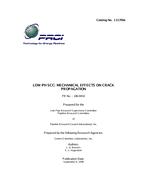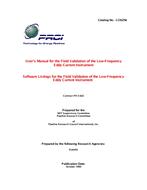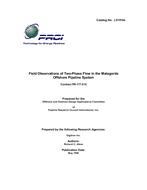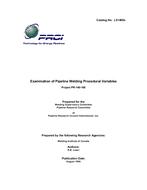Provide PDF Format
PRCI PR-186-9402
- Low-pH SCC: Mechanical Effects on Crack Propagation
- Report / Survey by Pipeline Research Council International, 09/06/1996
- Publisher: PRCI
$325.00$649.00
L51760e
Cortest Columbus Technologies, Inc.
Need: The first incident of external stress corrosion cracking (SCC) on natural gas pipelines occurred in the mid 1960's and hundreds of failures have occurred since that time. Currently, there is a poor understanding of the effects of mechanical factors (operating pressure, pressure fluctuations, and hydrotesting) on low-pH stress corrosion crack propagation. A better definition of the role of mechanical factors on low-pH stress corrosion crack propagation is needed to aid in the prediction of crack growth rates on operating pipelines and to develop strategies to mitigate this form of cracking.
Benefit: The objective of this project was to determine the roles and synergistic effects of pressure, pressure fluctuations, and hydrotesting on low-pH stress corrosion crack (SCC) growth. The project consisted oth three tasks: 1) to prepare test specimens and experimental apparatus and to establish a standard test protocol for conducting cyclic load tests and analyzing the test data; 2) to evaluate the effects of frequency, R ratio, and waveform on SCC growth in low pH environments; and 3) to evaluate the influence of hydrostatic pipeline testing on subsequent SCC growth in low-pH environments.
Result: During the project, three servo-hydraulic test frames were set up and calibrated. Test cells were designed and constructed and specimens for testing were prepared. Preliminary experiments were run to develop and fine tune the test and data analysis procedures. A total of twelve tests were completed on the project. The first four tests were performed with a triangular waveform, an initial R ratio (minimum/maximum load) of 0.9, and a frequency of 10-5 Hz All of the later tests were performed with a trapezoidal waveform: a load up to the maximum load, a hold at the maximum load, and a rapid unloading rate. Changing the waveform, from triangular to trapezoidal, decreased the cracking velocity slightly, but the effect may be within experimental variation. Under steady state cycling, typical cracking velocities were around 1 to 2 x 10-8 mm/s. Unlike the constant displacement rate tests, crack velocities were not a strong function of the magnitude of the J integral in the cyclic load tests. Several unplanned overloads of the specimens occurred in the testing and these inhibited subsequent crack growth. Crack growth occurred at a higher rate during periodic planned load increases, but returned to the 10-8 mm/s range following the load increases. Reloading following unloading caused a similar increase in the crack velocity during the half cycle of the reloading.
Cortest Columbus Technologies, Inc.
Need: The first incident of external stress corrosion cracking (SCC) on natural gas pipelines occurred in the mid 1960's and hundreds of failures have occurred since that time. Currently, there is a poor understanding of the effects of mechanical factors (operating pressure, pressure fluctuations, and hydrotesting) on low-pH stress corrosion crack propagation. A better definition of the role of mechanical factors on low-pH stress corrosion crack propagation is needed to aid in the prediction of crack growth rates on operating pipelines and to develop strategies to mitigate this form of cracking.
Benefit: The objective of this project was to determine the roles and synergistic effects of pressure, pressure fluctuations, and hydrotesting on low-pH stress corrosion crack (SCC) growth. The project consisted oth three tasks: 1) to prepare test specimens and experimental apparatus and to establish a standard test protocol for conducting cyclic load tests and analyzing the test data; 2) to evaluate the effects of frequency, R ratio, and waveform on SCC growth in low pH environments; and 3) to evaluate the influence of hydrostatic pipeline testing on subsequent SCC growth in low-pH environments.
Result: During the project, three servo-hydraulic test frames were set up and calibrated. Test cells were designed and constructed and specimens for testing were prepared. Preliminary experiments were run to develop and fine tune the test and data analysis procedures. A total of twelve tests were completed on the project. The first four tests were performed with a triangular waveform, an initial R ratio (minimum/maximum load) of 0.9, and a frequency of 10-5 Hz All of the later tests were performed with a trapezoidal waveform: a load up to the maximum load, a hold at the maximum load, and a rapid unloading rate. Changing the waveform, from triangular to trapezoidal, decreased the cracking velocity slightly, but the effect may be within experimental variation. Under steady state cycling, typical cracking velocities were around 1 to 2 x 10-8 mm/s. Unlike the constant displacement rate tests, crack velocities were not a strong function of the magnitude of the J integral in the cyclic load tests. Several unplanned overloads of the specimens occurred in the testing and these inhibited subsequent crack growth. Crack growth occurred at a higher rate during periodic planned load increases, but returned to the 10-8 mm/s range following the load increases. Reloading following unloading caused a similar increase in the crack velocity during the half cycle of the reloading.
Related Products
PRCI PR-3-822
Field Validation of Low-Frequency Eddy Current Instrument: User's Manual and Software Listings..
$48.00 $95.00
PRCI PR-177-515
Field Observations of Two-Phase Flow in the Matagorda Offshore Pipeline System..
$448.00 $895.00





